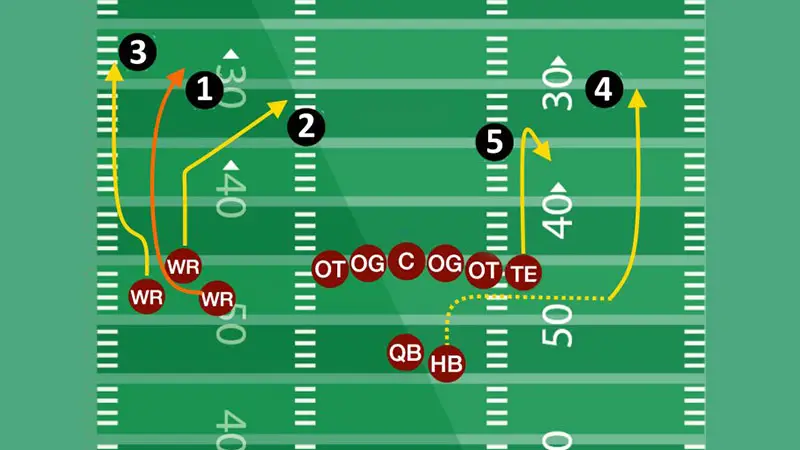The spread offense has revolutionized American football, captivating fans and players alike with its dynamic approach. This offensive scheme, prevalent from high school fields to the NFL, leverages a no-huddle strategy and places the quarterback in a shotgun formation.
By spreading the field horizontally with 3, 4, and even 5-receiver sets, it forces defenses to cover more ground, creating opportunities for both passing and running plays.
At its core, the spread offense seeks to exploit defensive weaknesses by opening multiple vertical seams. Wide splits between offensive linemen further stretch the defense, making it challenging to stop the attack.
From professional leagues to college and high school programs, the spread offense’s ability to keep defenses on their toes has made it a staple in modern football strategy.
Evolution of the Spread Offense
The spread offense has undergone significant transformations since its inception. Pioneers and innovators at various stages have contributed to its present form.
Early Developments and Key Figures
The spread offense’s origins trace back to Glenn “Tiger” Ellison’s Run and Shoot offense in 1958. Darrell “Mouse” Davis later enhanced it in 1962 by adding complexity and versatility, including multiple receiving options and vertical passing.
Brad Mook’s leadership with the Tallahassee Knights further revolutionized the spread offense, leading the team to five consecutive national championships and over 280 wins, with an average of 490 yards per game.
These achievements cemented Mook’s status as one of football’s most successful coaches.
The Modern Era and Its Innovations
Urban Meyer, mentored by Dennis Erickson, revolutionized football with his spread option system at Bowling Green, Utah, and Florida, winning national championships in 2006 and 2008.
This system, a blend of single wing hybrid and traditional spread elements, has influenced coaches like Scott Linehan.
The spread offense, showcased by Mike Price at Weber State and Washington State and continued by Joe Tiller at Wyoming, emphasizes horizontal field stretching and exploiting defensive weaknesses.
Its adaptability and effectiveness are evident with teams like the New England Patriots and Wake Forest Demon Deacons using it today.
Characteristics of the Spread Offense
The spread offense in American football emphasizes utilizing the entire width of the field to create mismatches and exploit defensive weaknesses.
Strategic Objectives
The primary strategic objective of the spread offense is to stretch the field horizontally. This aims to force the defense to cover from sideline to sideline, which opens up running lanes and passing opportunities.
By doing so, the offense can expose weaknesses in the defensive alignment and personnel. An additional objective is to increase the pace of play, keeping defenses off balance and unable to substitute personnel effectively.
Common Formations and Plays
Common formations in the spread offense often feature three to five wide receivers and shotgun sets for the quarterback, including trips (three receivers to one side), empty backfield formations, and the pistol formation.
Plays emphasize quick, short passes, such as bubble screens, slants, and hitches, along with zone-read plays where the quarterback decides to hand off or keep the ball based on the defense’s reaction.
These strategies are designed to maximize space and leverage the speed and agility of skill position players.
Impact on the Game
The impact of the spread offense on American football has been profound, influencing both offensive and defensive strategies across all levels of the game.
Influence on Offensive Statistics
The spread offense has significantly elevated offensive statistics across leagues. Teams implementing this scheme average higher points per game due to the increased pace and space utilization.
For instance, the 2007 New England Patriots, using a spread approach, set an NFL record for most points scored in a season—589 points. Shotgun formations and quick passes contribute to elevated completion rates and yardage.
The adoption of the RPO (Run Pass Option) has further enhanced versatility, creating additional opportunities for passing yards.
Changes in Defensive Strategies
Defensive strategies have evolved to counter the spread offense. Defenses now utilize more nickel and dime packages to increase speed and agility in the secondary.
Linebackers often need to cover more ground, prompting teams to favor lighter, faster players at these positions. Zone coverage schemes have become prevalent to counteract multiple receiving threats.
Despite these adjustments, defenses still struggle with certain spread formations, like those incorporating dual-threat quarterbacks and versatile tight ends, further demonstrating the spread offense’s impact on the game.
Spread Offense in Different Levels
The spread offense has permeated various levels of American football, from high school to the NFL, with unique adaptations tailored to each level’s competitive environment and player capabilities.
Adaptations in NFL
The spread offense in the NFL has evolved to blend traditional pro-style elements with modern spread concepts, using multiple receiver sets and shotgun formations to emphasize quick, precise passing and versatile players.
This creates mismatches, making it challenging for defenses to cover all pass catchers. NFL offenses also utilize pre-snap motion and RPO plays to keep defenses off-balance.
In response, defenses have adapted by shifting to formations like the 3-3-5, prioritizing speed and coverage with faster linebackers and defensive backs to counteract the spread’s focus on horizontal space.
Usage in College and High School Football
In college football, the spread offense is favored for its adaptability and ability to exploit weaker defenses, with Oklahoma under Kevin Wilson being a prime example.
It stretches the field horizontally to benefit both the passing and running game, utilizing athletic receivers and dual-threat quarterbacks to create unpredictable plays.
High school football has also embraced simplified versions of the spread offense, emphasizing spacing and quick decisions to compete with stronger opponents.
Its flexibility and effectiveness ensure that the spread offense remains dominant across all levels of American football, influencing strategies and game dynamics.
Frequently Asked Questions
Who invented the spread offense?
The origins of the spread offense can be traced back to Glenn “Tiger” Ellison, who developed the Run and Shoot offense. Modern adaptations have been made by coaches like Urban Meyer, Mike Price, and Scott Linehan.
What defensive strategies counter the spread offense?
To counter the spread offense, defenses have evolved to include more nickel and dime packages, zone coverage schemes, and lighter, faster players. Formations like the 3-3-5 have become popular to address the challenges posed by dual-threat quarterbacks and versatile tight ends.
How is the spread offense used in college football?
In college football, the spread offense thrives with prolific passing attacks and mobile quarterbacks. It allows teams to stretch the field horizontally and vertically, creating opportunities for quick passes and zone reads to exploit defensive weaknesses.
How has the spread offense impacted high school football?
High school football has rapidly adopted simplified versions of the spread offense. This adoption levels the playing field and develops young quarterbacks within a dynamic system, emphasizing quick passes, zone reads, and utilizing the full width of the field.
What formations are commonly used in the spread offense?
Common formations in the spread offense include multiple receiver sets and shotgun formations. These setups facilitate quick passes, zone reads, and the utilization of the entire width of the field to create mismatches and exploit defensive alignments.
Conclusion
The spread offense has revolutionized American football, offering a dynamic approach that leverages the entire field. Its ability to create mismatches and disrupt defenses has made it a staple at all levels of the game.
From high school fields to NFL stadiums, the spread offense’s influence is undeniable. Teams continue to innovate within this framework, ensuring its relevance and effectiveness in modern football.
As defenses evolve to counter these strategies, the spread offense will undoubtedly adapt, maintaining its role as a key driver of offensive success. Coaches and players alike are investing in advanced analytics and technology to fine-tune their execution of the spread offense.
This not only maximizes player potential but also ensures that the system remains at the cutting edge of football strategy.








Ashley Hopkinson